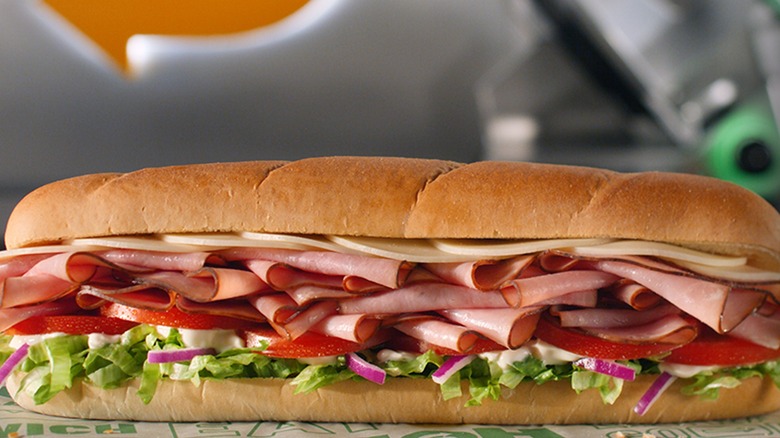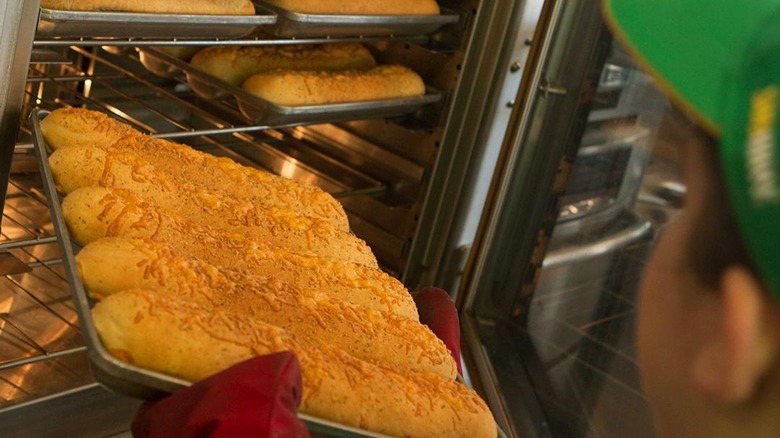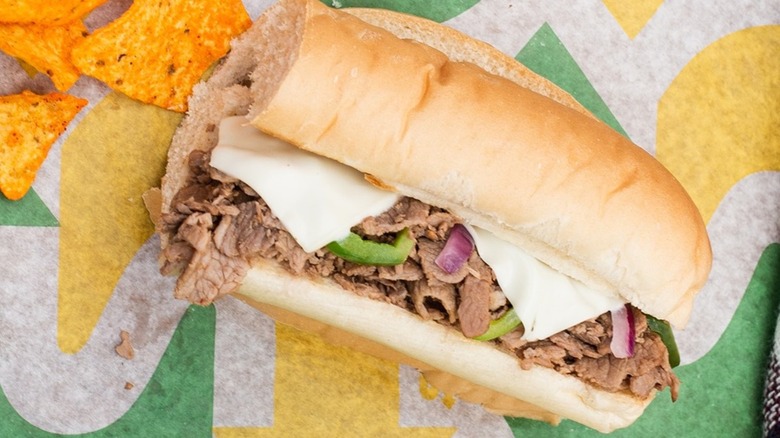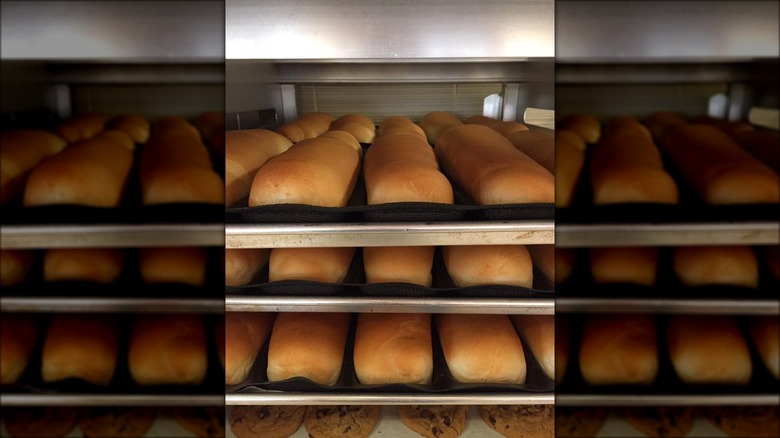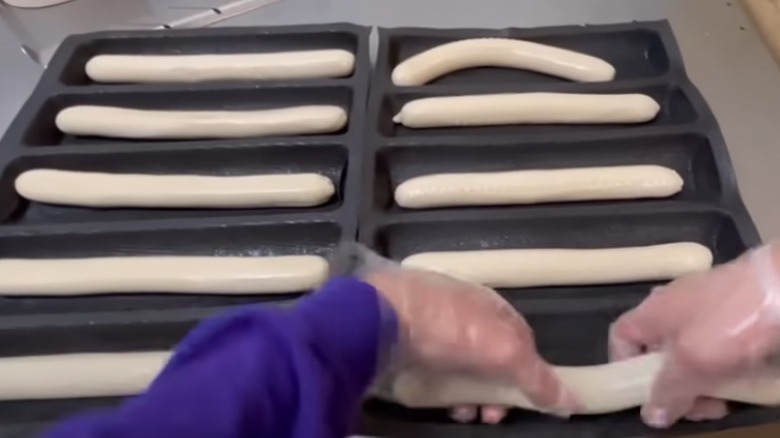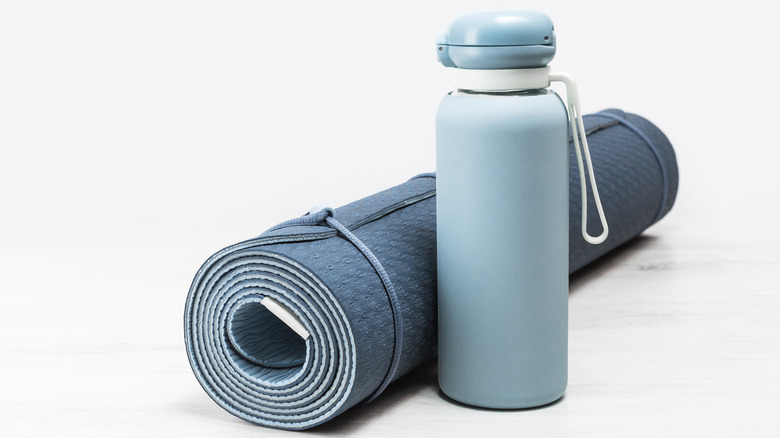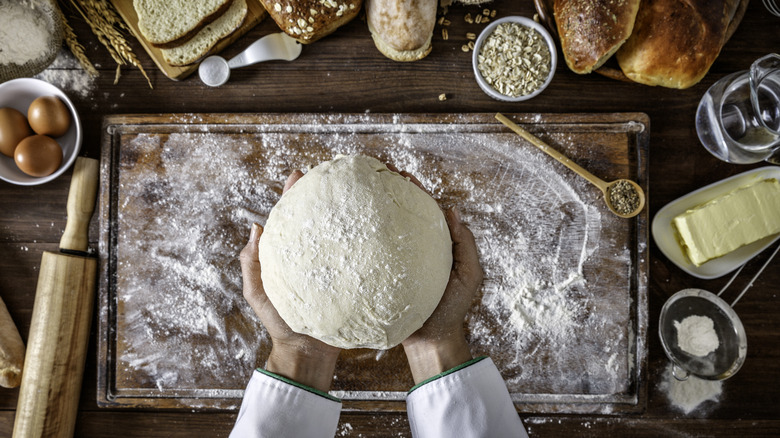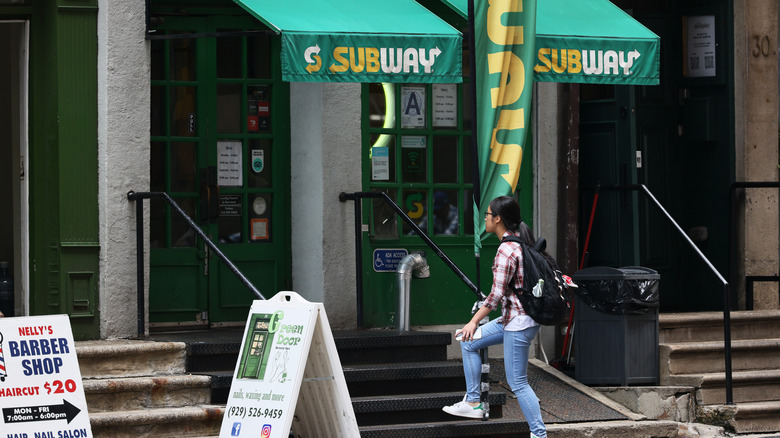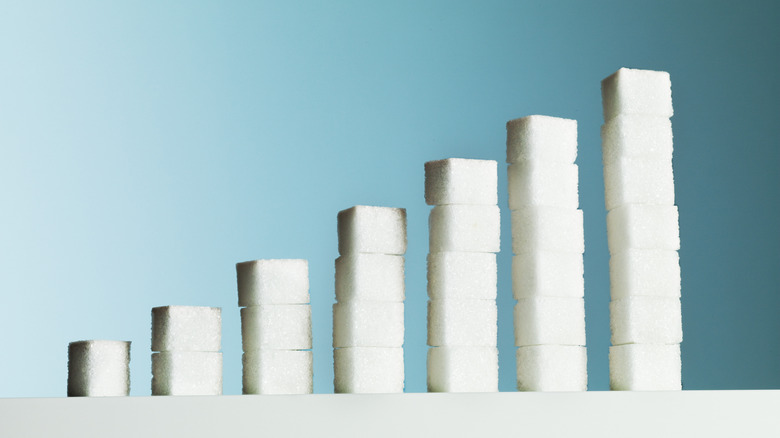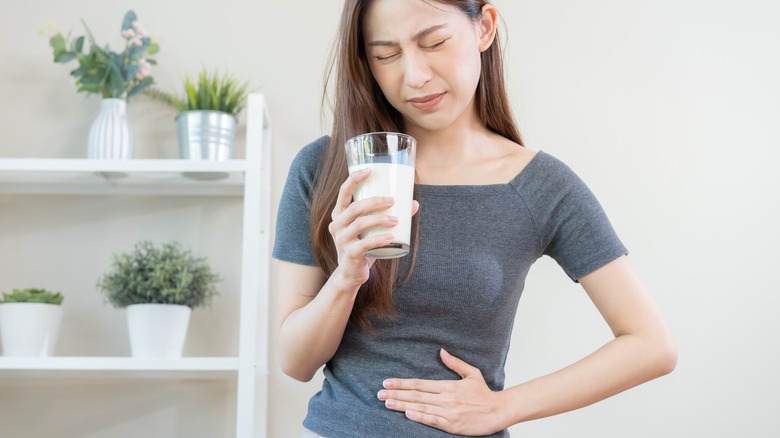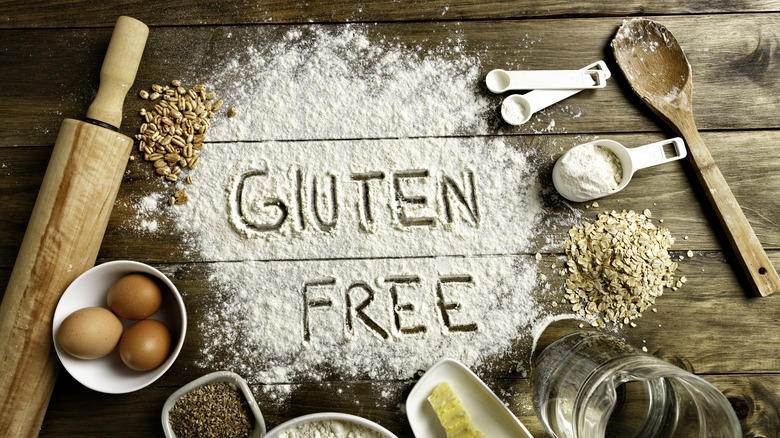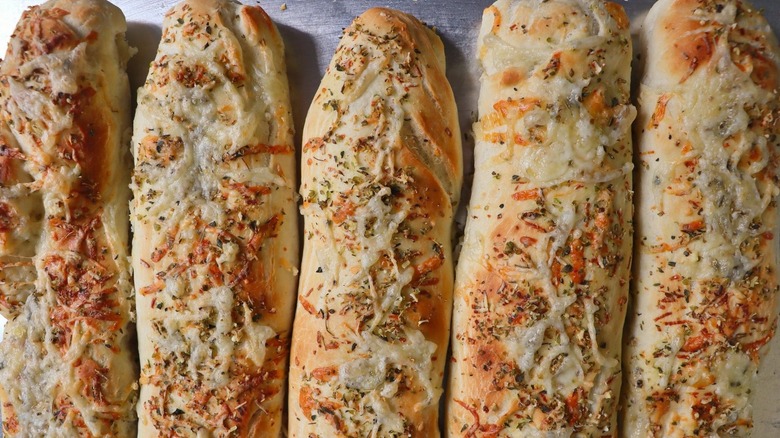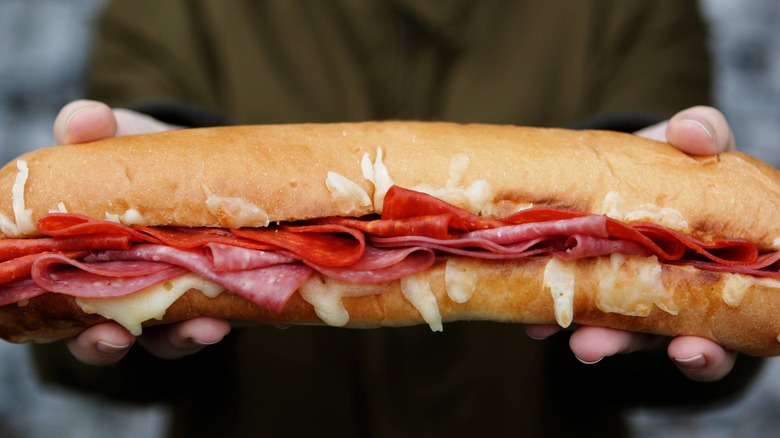Everything You Need To Know Before Ordering Subway's Bread
Before you eat your next Subway sandwich, you should learn more about the ingredient that turns ordinary sandwich fixings into a submarine sandwich — the bread. Before deciding on your toppings, you must determine what type of bread will hold them. After all, the bread is the foundation of any good sandwich and how satisfied you will be with your meal. So, it's time you learned everything there is to know about Subway bread before you take another bite.
If you walk into a busy Subway that has tons of bun options, you may not know what to pick, but we have the lowdown on the most popular and least popular choices. There are other things that you'll want to know, too — like how to get the freshest bread, what ingredients to expect, and hacks to make it even tastier. Subway bread has had its fair share of controversy. It's been the subject of conspiracy theories, had a questionable ingredient removed, and has even been declared not to be bread in one country. As you can guess, there are probably a lot of things you didn't know about the unsung hero of your sub. So, let us educate you more about the interesting world of Subway bread.
Subway bread is baked fresh on-site daily
One of the first things you notice when you walk into a Subway sandwich shop is the smell of freshly baked bread. However, Subway's signature fresh bread scent has not always been a part of the Subway experience. When Subway opened in 1965, it didn't make its own bread. After all, when Fred DeLuca opened up his first restaurant, he was only 17 years old, and it was a simple submarine sandwich shop. It wasn't until 1983 that the chain began to bake its own buns in each restaurant daily.
The tradition of freshly baked bread in each store continues today. However, the number of times a store bakes it freshly each day depends on how busy it is and how fresh the location wants to keep it. Some locations bake bread in the morning and then again later in the day if needed, while others keep baking it all day to meet demand.
You should always ask for the softest bread
The fact that the bread is baked fresh daily often doesn't necessarily mean that you'll get some that was made that day. If you order it earlier in the day while it's still baking and cooling, you may get yesterday's bread. Some locations have a rule to never serve any that's older than eight hours. Meanwhile, other franchise owners may even insist on selling day-old or even two-day-old bread to avoid food waste and maximize profits.
Bread texture changes depending on when it's baked. It's the most moist and elastic during the first 24 hours. During the second 24 hours, it starts to lose its moisture, but it does become easier for Subway employees to slice on day two.
If you care more about getting the freshest bread for your sandwich than its flavor profile, there's a hack you can use. Simply ask the employee making your sandwich which bread is softest today, and you're sure to get some that was baked most recently. Since they've been slicing buns their whole shift, they probably have a good idea which one is softest. Of course, that might mean that it's one of the least popular varieties, but it also might mean that it's just come straight from the oven, too.
Waiting for your favorite bread to bake isn't usually a realistic option
You might have heard that it only takes 13 to 22 minutes to bake Subway's bread, and that's true. So, it makes sense to think you could ask an employee to bake your favorite variety if the restaurant runs out. However, the process is more involved and takes longer than you think. It's not a matter of just sticking the loaf into the oven and pulling it out for your sandwich.
Every loaf starts frozen and is not ready to bake until thawing and proofing. Any loaf the restaurant makes needs 8-12 hours of retarding, 20 minutes of floor retarding, 50 to 60 minutes of proofing, 13 to 22 minutes of baking, and 30 minutes of cooling. Thus, the total time it takes from freezer to customer is 10 to 14 hours. Different loaf sizes and types take longer to proof so it could take even longer. Waiting that long isn't reasonable. Even if the dough has already gone through the retarding process and only has to proof, bake, and cool, you'll be waiting around two hours or more.
You might only want to wait for a freshly baked loaf if it's already in the oven and you have 33 to 52 minutes to burn or if you can wait a half hour for a freshly baked loaf to cool. Yes, you'll need to wait for it to cool because it will collapse and harden without cooling.
Subway bread dough is made and shaped off-site
As we've mentioned, each Subway loaf starts frozen. While Subway employees bake each loaf fresh on-site, they don't mix the ingredients to make the dough. Subway has several suppliers that create the dough for the various franchise locations use to make their bread. Some of these suppliers include Lineage Logistics, Aryzta, and Southwest Baking.
It's these companies that work to create the recipes Subway uses for its dough. If Subway has a new bread goal or type in mind, it goes to these companies to make it happen. For example, when Subway decided to increase the whole grain content of its foot-long wheat bread loaf to meet 100% of an individual's daily whole grain requirement, it looked to these companies to do it. These companies have also assisted Subway with reaching other nutritional goals like increasing fiber content, removing trans fats, fortifying the dough with Vitamin D and calcium, removing high fructose corn syrup, and decreasing sodium content in some varieties.
In 2021, the COVID-19 pandemic began to change customer habits from eating in restaurants to placing more carryout orders and using delivery services. Thus, Subway tasked Aspire Bakeries with creating bread that would keep its texture longer after being filled with wet ingredients and sauces. The company also helped formulate new recipes to help overcome ingredient shortages.
It once contained an ingredient used to make yoga mats more elastic
In 2014, Subway was part of an unusual food scandal. It turned out that one of the ingredients in its bread was also a chemical used to make products like yoga mats, shoes, and fake leather. The ingredient in question was azodicarbonamide (ADA), which creates tiny gas bubbles in plastics to make them more spongy. Subway wasn't the only restaurant using this yoga mat chemical in its foods. It also appeared in buns at McDonald's, Burger King, Starbucks, and store brands like Roman Meal, Sunbeam, and Wonder.
While eating a sandwich wrapped in yoga mat bread doesn't sound very appetizing, a food-grade version of the chemical is FDA-approved for conditioning and strengthening the dough to provide a puffier end product. The FDA says that the amount allowed in bread is safe and that it has only been known to be carcinogenic in mice (and only female mice) at higher levels than it has approved for baking. Meanwhile, in the EU and Australia, the chemical is banned for dough.
When food Vani Hari launched a petition on her Food Babe blog for Subway to remove the yoga mat chemical from its ingredient list, over 101,000 people signed it. Subway reacted quickly, saying it had already been doing consumer testing with recipes that didn't contain the yoga mat chemical. Once it got the final government approvals, it was able to shift to a non-ADA bread.
The ingredients in Subway bread are cleaner than you'd expect
As new health trends have emerged, Subway has worked to remove suspect chemicals and ingredients from its bread. In the 2000s, it worked to increase fiber content, remove trans fats, and change the whole grain content of its whole wheat bread. In the 2010s, it removed high fructose corn syrup, reduced sodium, increased whole grains in its 9-grain bread, began fortifying its loaves with vitamins and minerals, and removed azodicarbonamide.
When you look at the ingredient list for the different breads Subway sells, you'll mainly find ingredients you would use in your own kitchen. These ingredients include flour, salt, oil, vinegar, yeast, and sugar. Some more complex breads will have added ingredients like cheese, spices, and various grains. You'll also see vitamins and minerals listed among the ingredients since Subway uses enriched flour.
However, you will see a few ingredients in some varieties you don't likely have in your cupboard at home. For example, you'll see the emulsifier soy lecithin on the list. You'll also see enzymes and anti-caking agents like cellulose or silicon dioxide (within the FDA's safety guidelines) on the ingredient list. A few even have preservatives or mold inhibitors to help keep extra ingredients like cheese or jalapeños from spoiling. There is still one concerning preservative on the jalapeño cheddar bread ingredient list — sodium metabisulfite, which the Cleveland Clinic says can cause allergic or asthmatic reactions in some people.
The smell has been the subject of a conspiracy theory
If you've been anywhere near a Subway sandwich shop, you've likely been lured (or possibly repelled) by the smell of freshly baked bread. But it's more than an ordinary bread smell. Because people can often smell it from outside as they pass by, many have suggested Subway has a special scent they pump out into the world to snag potential customers.
Mark Christiano, Subway's Global Baking Technologist, told Food Republic that Subway wasn't intentionally filling the air outside the store with the smells of freshly baked bread. However, he did say, "We are proud of the smell. Any baked product smells good. And we want you to catch that bread aroma." Ultimately, he denied that the chain bakes with specific chemicals or adds chemicals to its pans that might contribute to the scent. Instead, he says it comes from "a combination of the baking process and the percentage of different ingredients."
Vice went as far as to try recreating Subway bread at home from the online ingredient list. Baking the plain variety didn't produce the iconic aroma. However, when they started adding Italian herbs to the recipe and making cookies, they said it suddenly "smelled exactly like 4 PM outside a suburban Subway store. As my oven began blasting the combined scent of basil and macadamia cookies, I knew I'd done it." So, it's not any special scent at all; it's the combination of everything Subway bakes in its ovens.
Subway bread is not legally considered bread in Ireland
U.S. consumers have grown so accustomed to eating sweet bread that we often don't notice how sweet some of our brands are. However, in Ireland, Subway sandwich bread isn't even considered bread. Irish supreme court judges stripped Subway bread of its bread status in 2020 when it examined its sugar content.
Ireland's standard Value Added Tax (VAT) is a different percentage based on what you're buying. The standard tax rate is 23%, with food items being among those sometimes taxed less or not at all based on what they are. Ireland taxes for more indulgent treats (like chips and cakes) while giving you a break on the basics (like eggs and milk). Bread is among the food staples that don't have tax added to the price when you buy it. The original Value-Added Tax Act of 1972 stipulated that the dough couldn't be more than 2% sugar to be considered bread. Thus, it was important for Ireland to analyze the content of Subway's bread to determine if it needed to be taxed or not. Unfortunately, it failed, with the dough being 10% sugar. It turned out that eating a 6-inch sub is the equivalent of eating two British digestive-style cookies (per The Guardian). So, next time you're eating a Subway sandwich, remember that the bun is technically cake in Ireland, with a footlong bun containing four to eight grams of sugar.
Many Subway breads aren't dairy-free or vegan
If you eat dairy-free or vegan, it's important to note that not all the breads at Subway are suitable for your diet. The obvious offenders are the varieties with cheese in their names, like Italian herbs and cheese, jalapeño cheddar, Monterey cheddar, and Parmesan oregano. However, there are two other varieties that you'll want to stay clear of as well because of their milk or lactose content: the multigrain flatbread and the artisan flatbread. The multigrain flatbread contains milk, and the artisan flatbread may contain milk.
The Subway varieties that are dairy-free and vegan include artisan Italian white bread, gluten-free bread, hearty multigrain, sourdough, spinach wrap, tomato basil wrap, and plain wrap. So, depending on what your location offers, there are plenty of choices.
You'll want to always check Subway's "Allergy and Sensitivity Table" or its "Product Ingredient Guide" because the ingredients sometimes change. For example, we found artisan flatbread listed as being vegan on a vegan website. However, Subway lists it as a variety that may contain dairy or lactose.
Subway once had gluten-free bread available
Subway first started rolling out gluten-free bread in some U.S. locations in 2011. You could even find it in some other countries as well. With so few fast food chains offering gluten-free bread options, it set Subway apart. While you could still find it listed on Subway's 2022 product list as a local or regional option, it's missing from the 2023 list. It looks like it disappeared quietly into the night without any fanfare. In fact, one page we found on England's Subway website that mentioned gluten-free bread as an option vanished as we were writing this article.
Perhaps the gluten-free bun will return if enough people ask for it, but we're guessing not since it had a good run. After all, it had risks for those with the most extreme gluten sensitivities. It came pre-packaged and frozen and was made in a gluten-free facility. Still, an anonymous Redditor said, "I'm always concerned about cross-contamination. The oven they toast, the knife they use, whether the toppings were touched by gloves after touching normal bread.... It's not worth the stress to me nor the price when I may react all the same." With these types of sentiments, the bun's days were always numbered.
Americans have a clear favorite and least favorite bread at Subway
When Mashed polled Subway customers to find out which bread they liked best, there was a clear winner and a clear loser. A full 46% of those we asked preferred the Italian herbs and cheese bread. In another poll, we asked customers which bread they'd never get, and 37% expressed their dislike for jalapeño cheddar bread.
Even if your local shop isn't bustling and only bakes a handful of bun varieties for customers, Italian herbs and cheese is one you'll see because it's a favorite. The flavor of Italian herbs and cheese comes from Monterey Jack cheese, cheddar cheese, and a Parmesan-oregano topping full of all sorts of spices and garlic.
Jalapeño cheddar bread also contains Monterey Jack cheese and cheddar cheese. People get it because the baked-in jalapeños and other natural flavors represent a spicier option. When it first came out on the first day of 2014, it was a hit. It disappeared for a while and returned with a new recipe on the first day of 2018. There are certainly people who like it, but jalapeño just doesn't appeal to everyone.
There's a hack that can make your Subway bread tastier
Don't you just love it when there's a new hack you've never heard of to make something you love taste even better? The Subway bread hack is a way to keep it perfectly soft and cheesy for toasted sandwiches. This hack is a trick that Redditor u/mincerafte1969 learned from working at Subway. "Ask for the oil and cheese to be put on the bread under your meats, so your bread is soft and cheesy when it's put in the oven. Put your sauces on before your veggies, otherwise the sauce won't soak into the meat or the bread and it'll just slide off the veggies."
So, the correct layer order for making the sandwich is bread, oil, cheese, meat, veggies, and more bread. The oil and cheese soak into the bun during the toasting process, optimizing the flavor and helping to keep the bun soft. While the oil and condiment station tends to be at the end of the sandwich assembly line, an employee who wants to make their customers happy won't mind changing the process for you.
